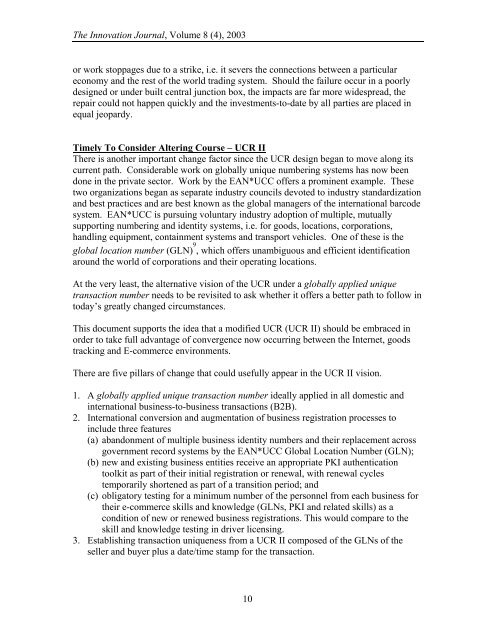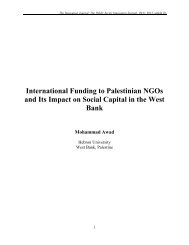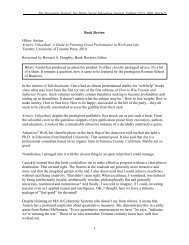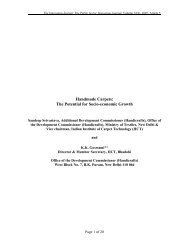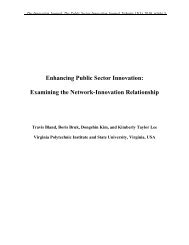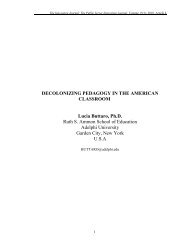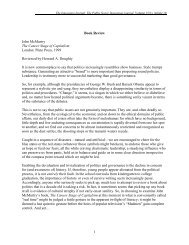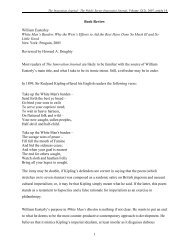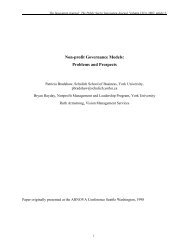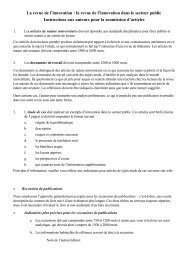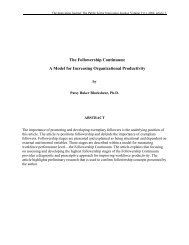Trade Corridor Transparency and Security - The Innovation Journal
Trade Corridor Transparency and Security - The Innovation Journal
Trade Corridor Transparency and Security - The Innovation Journal
Create successful ePaper yourself
Turn your PDF publications into a flip-book with our unique Google optimized e-Paper software.
<strong>The</strong> <strong>Innovation</strong> <strong>Journal</strong>, Volume 8 (4), 2003<br />
or work stoppages due to a strike, i.e. it severs the connections between a particular<br />
economy <strong>and</strong> the rest of the world trading system. Should the failure occur in a poorly<br />
designed or under built central junction box, the impacts are far more widespread, the<br />
repair could not happen quickly <strong>and</strong> the investments-to-date by all parties are placed in<br />
equal jeopardy.<br />
Timely To Consider Altering Course – UCR II<br />
<strong>The</strong>re is another important change factor since the UCR design began to move along its<br />
current path. Considerable work on globally unique numbering systems has now been<br />
done in the private sector. Work by the EAN*UCC offers a prominent example. <strong>The</strong>se<br />
two organizations began as separate industry councils devoted to industry st<strong>and</strong>ardization<br />
<strong>and</strong> best practices <strong>and</strong> are best known as the global managers of the international barcode<br />
system. EAN*UCC is pursuing voluntary industry adoption of multiple, mutually<br />
supporting numbering <strong>and</strong> identity systems, i.e. for goods, locations, corporations,<br />
h<strong>and</strong>ling equipment, containment systems <strong>and</strong> transport vehicles. One of these is the<br />
global location number (GLN) 9 , which offers unambiguous <strong>and</strong> efficient identification<br />
around the world of corporations <strong>and</strong> their operating locations.<br />
At the very least, the alternative vision of the UCR under a globally applied unique<br />
transaction number needs to be revisited to ask whether it offers a better path to follow in<br />
today’s greatly changed circumstances.<br />
This document supports the idea that a modified UCR (UCR II) should be embraced in<br />
order to take full advantage of convergence now occurring between the Internet, goods<br />
tracking <strong>and</strong> E-commerce environments.<br />
<strong>The</strong>re are five pillars of change that could usefully appear in the UCR II vision.<br />
1. A globally applied unique transaction number ideally applied in all domestic <strong>and</strong><br />
international business-to-business transactions (B2B).<br />
2. International conversion <strong>and</strong> augmentation of business registration processes to<br />
include three features<br />
(a) ab<strong>and</strong>onment of multiple business identity numbers <strong>and</strong> their replacement across<br />
government record systems by the EAN*UCC Global Location Number (GLN);<br />
(b) new <strong>and</strong> existing business entities receive an appropriate PKI authentication<br />
toolkit as part of their initial registration or renewal, with renewal cycles<br />
temporarily shortened as part of a transition period; <strong>and</strong><br />
(c) obligatory testing for a minimum number of the personnel from each business for<br />
their e-commerce skills <strong>and</strong> knowledge (GLNs, PKI <strong>and</strong> related skills) as a<br />
condition of new or renewed business registrations. This would compare to the<br />
skill <strong>and</strong> knowledge testing in driver licensing.<br />
3. Establishing transaction uniqueness from a UCR II composed of the GLNs of the<br />
seller <strong>and</strong> buyer plus a date/time stamp for the transaction.<br />
10


